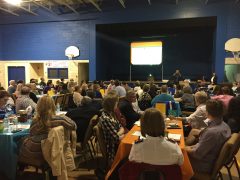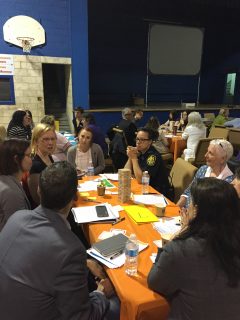by Keegan Hughes, CFICE Volunteer
The Community First: Impacts of Community Engagement (CFICE) project collaborates with many community partners in order to best serve Canadians. Using a community-first approach allows the project to reach many people in ways that other strategies could not. That is why a partnership with Living SJ, an organization dedicated to ending generational poverty in Saint John, is a perfect fit.

Event hosted by Living SJ June 9th entitled Living SJ: Building a Movement ©Melanie Hientz
Living SJ consists of many neighbourhoods, businesses, non-profits, and government departments that are all dedicated to making the impacts needed to end generational poverty. Living SJ believes that all levels of a community, from citizens to government, need to coordinate action and resources on key measurable priorities in order to bring about change and build a prosperous community. This is the collective impact approach adopted by Living SJ.

Promise Partnership is an initiative led out of the Vice-President’s Office at the University of New Brunswick (UNB) Saint John
The first project that CFICE and Living SJ worked together on was evaluating a mentorship program through University of New Brunswick – Saint John that connected university students with children experiencing lower literacy scores in a nearby neighbourhood school. Closing the education achievement gap is key to reducing generational poverty, says Living SJ Executive Director Cathy Wright
“The work with CFICE involved the university, the community, and involved the members from Close the Education Achievement Gap education team including schools,” Wright says.
CFICE has also enabled Living SJ to have an outside evaluator looking at our collective impact approach and our impact on the community, according to Wright. The project has also helped keep lines of communication open with different partners, including neighbourhoods.

Mentee and mentor read together as part of the mentorship program through the University of New Brunswick
“Measurement and communication are two of the tenements of collective impact,” says Wright.
The increased capacity to measure and communicate also helped Living SJ create tools to better connect with the community, and to tell their story. The key outcomes of these tools were two infographics. One infographic describes the Living SJ initiative, and the other maps out the wide range of partners involved in the initiative.
Wright says that working with CFICE allowed them to respond to specific needs in communities and to strengthen relationships with the University, which may not have been possible through other partnerships.

June 9th Living SJ: Building a Movement ©Melanie Hientz
“CFICE has fostered a number of opportunities where the criteria was very broad, and this lets a community decide what the initiatives should be . . . Having CFICE as a funding source that was more free ranging was very valuable to our work,” says Wright.
Although their next objective is not yet clear, Living SJ hopes to continue their partnership with CFICE. Living SJ’s duo of dedicated staff, together with the University, will be attending meetings, as well as deciding what kind of role they will be able to play as time goes on.
“What is clear is that we will be able to continue to build on what’s been accomplished as a result of our partnership with CFICE,” says Wright.